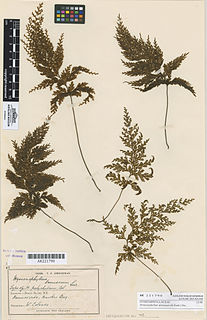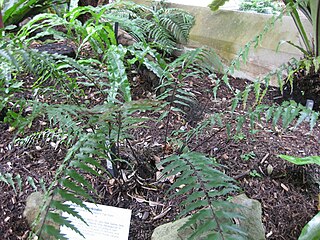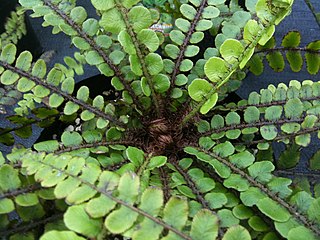Lake Waikareiti, also spelt Lake Waikare Iti, is located in Te Urewera National Park in the North Island of New Zealand. A number of hiking trails are found within the catchment basin of the lake.

Tmesipteris tannensis is a fern ally endemic to New Zealand. It is usually epiphytic on trees and tree ferns, but is occasionally terrestrial.

Leptecophylla juniperina is a species of flowering plant in the family Ericaceae. The species is native to New Zealand and the Australian states of Tasmania and Victoria. The plant's fruit is edible, raw or cooked. Plants grow best in areas with moderate winters and cool moist summers.

Microsorum pustulatum is a species of fern within the Polypodiaceae family. This species occurs widely in New Zealand and also in Queensland, New South Wales, Victoria and Tasmania in Australia. An example occurrence in the North Island of New Zealand is in the Hamilton Ecological District where it is associated with a number of other ferns including Blechnum filiforme and Blechnum discolor.

Microsorum scandens, commonly called fragrant fern is a species of fern within the Polypodiaceae family. This species occurs in parts of New Zealand and Australia. An example occurrence in New Zealand's North Island is in the Hamilton Ecological District where it is associated with a number of other ferns including Blechnum filiforme and Blechnum discolor.

Asplenium flaccidum is a species of fern in the family Aspleniaceae. The plant common name is drooping spleenwort or weeping spleenwort, and the species name flaccidum derives from the Latin root meaning drooping. An example occurrence of A. flaccidum is within a Nothofagus-Podocarp forest at Hamilton Ecological District on New Zealand's North Island in association with other fern species understory plants, crown fern, Blechnum discolor being an example.

Hymenophyllum demissum is a species of fern in the family Hymenophyllaceae. H. demissum is found in New Zealand, with a specific example occurrence being in North Island's Hamilton Ecological District in a Nothofagus-podocarp forest in association with other fern species understory plants, crown fern, Blechnum discolor being an example.

Alseuosmia is a genus of five species in the family Alseuosmiacea, growing in New Zealand's North Island. Species members are characteristically small evergreen shrubs. An example occurrence of species representative Alseuosmia macrophylla is in the habitat of the Hamilton Ecological District, where Blechnum discolor and Blechnum filiforme are understory elements with Nothofagus truncata and rimu overstory. Other species are A. banksii, A. pusilla, A. quercifolia, and A. turneri.

Alseuosmia macrophylla, the toropapa or karapapa, is a plant species in the family Alseuosmiaceae. This is a small evergreen shrub which is endemic to New Zealand, along with two closely related species. An example occurrence of A. macrophylla is in the North Island habitat of the Hamilton Ecological District, where Blechnum discolor and Blechnum filiforme are understory elements with Nothofagus truncata and rimu overstory. This plant is known for the pleasant scent of its flowers, and its family name translates as "perfumed grove". The small red berries of toropapa are edible and sweet tasting. As a forest understory plant, toropapa will not tolerate full sunlight or frost, and needs its roots to stay moist and cool, however so long as these conditions are met it is reasonably hardy, and is sometimes cultivated as a garden plant.

Asplenium polyodon, commonly known as sickle spleenwort, is a species of fern in the family Aspleniaceae. The distribution of A. polyodon includes parts of the countries of Australia and New Zealand. A specific locale of occurrence is in forested areas of Westland, New Zealand, where associate understory species include Crown Fern, Blechnum discolor.

Metrosideros perforata, also known as white rata, climbing rata, akatea or Akatorotoro, is one of twelve Metrosideros species endemic to New Zealand. It is one of three white flowering rātā vines.
Coprosma spathulata is a shrub that is native to New Zealand. An example occurrence of this species is within the Hamilton Ecological District in the North Island within a forest dominated by Nothofagus and rimu, where understory associates include Blechnum discolor and Doodia media.

Phyllocladus alpinus, the mountain toatoa or mountain celery pine, is a species of conifer in the Podocarpaceae family. It is found only in New Zealand. The form of this plant ranges from a shrub to a small tree of up to seven metres in height. An example occurrence of P. alpinus is within the understory of beech/podocarp forests in the north part of South Island, New Zealand.

The Spenser Mountains is a topographic landform in the northern South Island of New Zealand. Located at the southern end of the Nelson Lakes National Park and north of the Lewis Pass they form a natural border between the Canterbury and Tasman regions. Several peaks are named after characters in Edmund Spenser’s allegorical poem, The Faerie Queene. Many of the early explorers were evidently literate men. For example, Frederick Weld named Lake Tennyson; William Travers named the Spensers and Faerie Queene; Julius Haast named Mt Una.
Notogrammitis heterophylla is a species of fern within the family polypodiaceae ferns. The species is found in New Zealand, Tasmania and Victoria, Australia. This plant is epiphytic In New Zealand's Westland N. heterophylla occurs in association with other epiphytes such as Asplenium polyodon and Trichomanes reniforme.
Pseudopanax colensoi is a species of evergreen plant. This species is native to New Zealand. An example occurrence in central Westland podocarp/broadleaf forests includes flora associates such as Cyathea smithii and Dicksonia squarrosa, Rumohra adiantiformis, Ascarina lucida, Pseudowintera colorata and Blechnum discolor. The maximum height of this plant is 5 meters and it is the preferred food of possums.
Pseudopanax edgerleyi is a species of plant which is native to New Zealand. An example occurrence in Westland District Podocarp/broadleaf forests includes flora associates such as Cyathea smithii, Dicksonia squarrosa and Blechnum discolor.
Coprosma arborea is a species found in New Zealand. The flowers have insignificant petals and are wind pollinated, with long anthers and stigmas. The fruit is a non-poisonous juicy berry, containing two small seeds. A typical occurrence location of the species is in the Hamilton Ecological District in New Zealand's North Island.















